Behind the Barrel
From timber to toast, the life of a cask and the character it imparts.
The story of a great spirit begins with the barrel, one that has been told for centuries, starting in 350 BCE with the Celts. Valuable liquids such as spirits and oil were formerly transported in clay pots, but on the hunt for practicality and innovation, the Celts discovered the bending of wood to create staves and eventually, the barrel. Upon immediate improvement and dynasty-wide popularity, the barrel transcended the heavy and fragile clay pots and became widely adopted as the sole storage method for spirits, fish and even gunpowder.
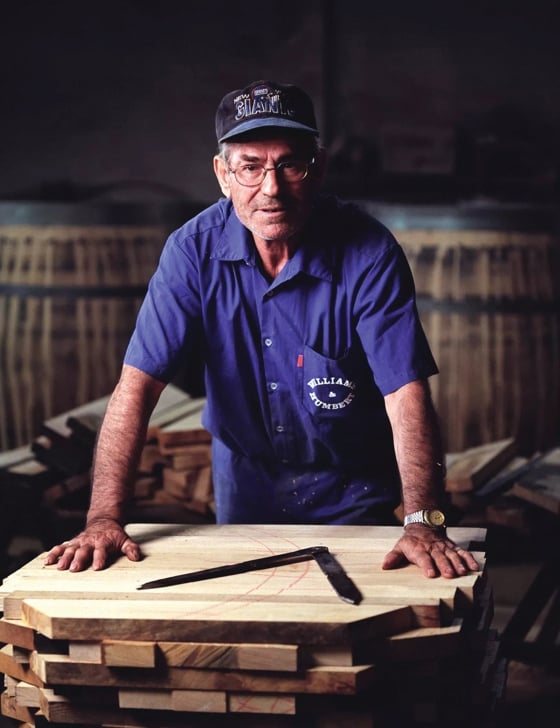


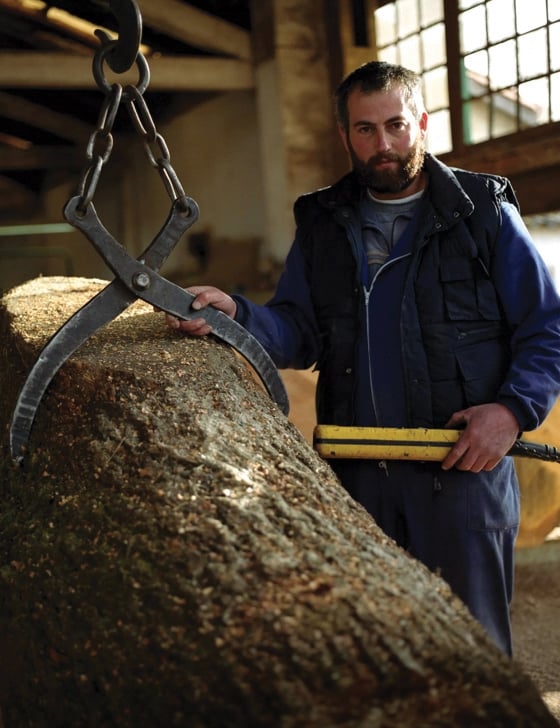
(left to right) Cooper building sherry oak whisky cask; Acorns mark the start of sustainable oak growth; Finished Sherry Cask; Oak tree in The Macallan cooperage.

Oak Terroir, Europe
The rise of the barrel remained steady, especially with the introduction of the toasted barrel to infuse its content with natural sugars and powerful flavors. This became particularly crucial in the 18th and 19th centuries in America with the discovery of what would become a signature spirit, bourbon. Earning a special place in the spirits world, distinctively, bourbon must be aged in a new charred oak container, primarily the American white oak.
Both American and European oak play a pivotal role in the aging of spirits, with American oak’s density and quicker maturation serving as the essential foundation for bourbon and its signature golden colors. European oak subtly contrasts its American counterpart as it develops a mahogany or darker gold color in whiskey as it matures, while also amplifying a rich tannin presence by almost five times more than the American oak.
Oak makes a good fit for barrels thanks to both its resistance to leakage and the flavor profiles it helps create, due to a variety of different components that interact with the spirit and each other. Cellulose primarily provides structure to the cell walls in the wood, hemicellulose and lignins are binders and wood extracts include various organic compounds such as tannins and resins. All of them vary from tree to tree, and other than cellulose, each has a different effect on flavor and aroma during the aging process. Lignins, for example, give vanilla and spice notes, while hemicellulose caramelizes and can yield notes such as brown sugar toffee. Wood extracts, including tannins, can contribute to flavors, colors and mouthfeel.
“The making of whiskey is a very complicated sequence of reactions,” says Andrea Wilson, Michter’s Master of Maturation and Chief Operating Officer, and a 2022 inductee into the Kentucky Bourbon Hall of Fame. “It’s not just about the recipe, yeast and distillation. It’s about that final ingredient being the barrel, because that’s a significant portion of what it takes to get from a clear spirit with beautiful fruit aromas, floral, grainy and sweet oiliness, to its final product state.”
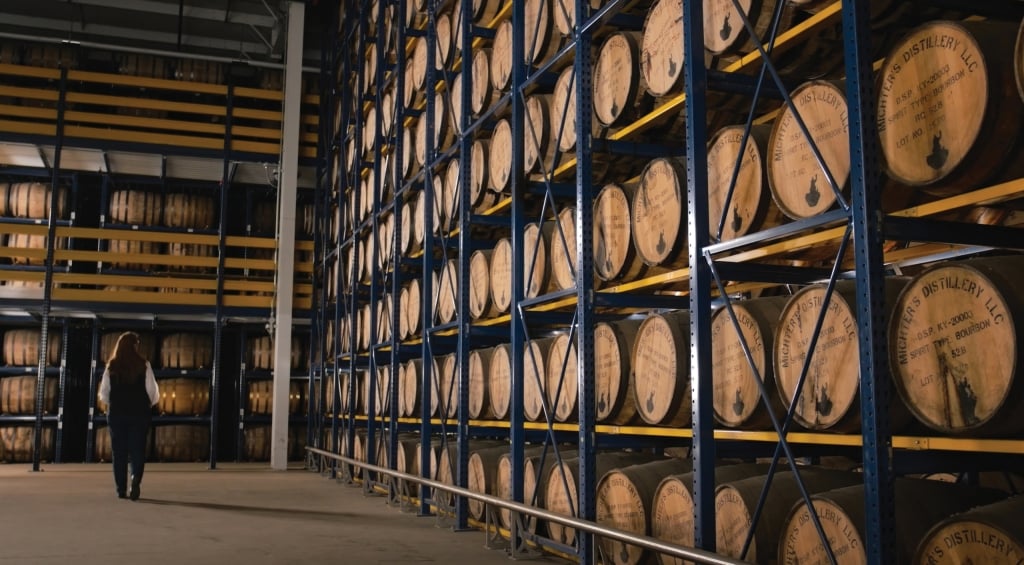
Andrea Wilson surveying Michter’s Distillery.
BUILT FOR TASTE
How flavor notes get imparted from the wood to the spirits starts with how the barrel is made — a labor intensive process requiring specialized equipment and craftsmanship. “A typical oak tree being used for a barrel takes around 70 or 80 years to grow, and you can only make one or two barrels per tree,” said Drew Mayville, Master Blender and Director of Quality for Sazerac, and a 45-year veteran of the spirits industry. “An average barrel is made up of around 32 individual pieces of oak, known as staves, and they’re normally from different trees.” The vital contribution of oak trees sits at the heart of the barrel’s value. This coveted product allows a singular ingredient to evolve across a lifetime.
Numerous factors go into wood selection, but one of the most important is the number of rings per inch, described as coarse grain or tight grain. “Keeping all the other variables constant, if you aged something for eight years in tight grain, it might taste immature, whereas using coarse grain might bring out much heavier oak flavors,” says Mayville. “So for an eight-year-old product, you might use an average between the two, but for a 50-year-old product, the tight grain might result in the best tasting whiskey.”
For Nic Wallace, Resort Bars and Spirits Manager at Sea Island, the art of barrel selection starts not with the wood itself, but with the people it’s meant to serve. “What is the target client and delivery for this spirit at the resort? We want everyone to love everything we offer, but our Single Barrel Selection is designed to be unique for a reason. They are targeted to either the connoisseur traveler who has seen it all that we want to wow, or for our bar teams to use in specific cocktails.”
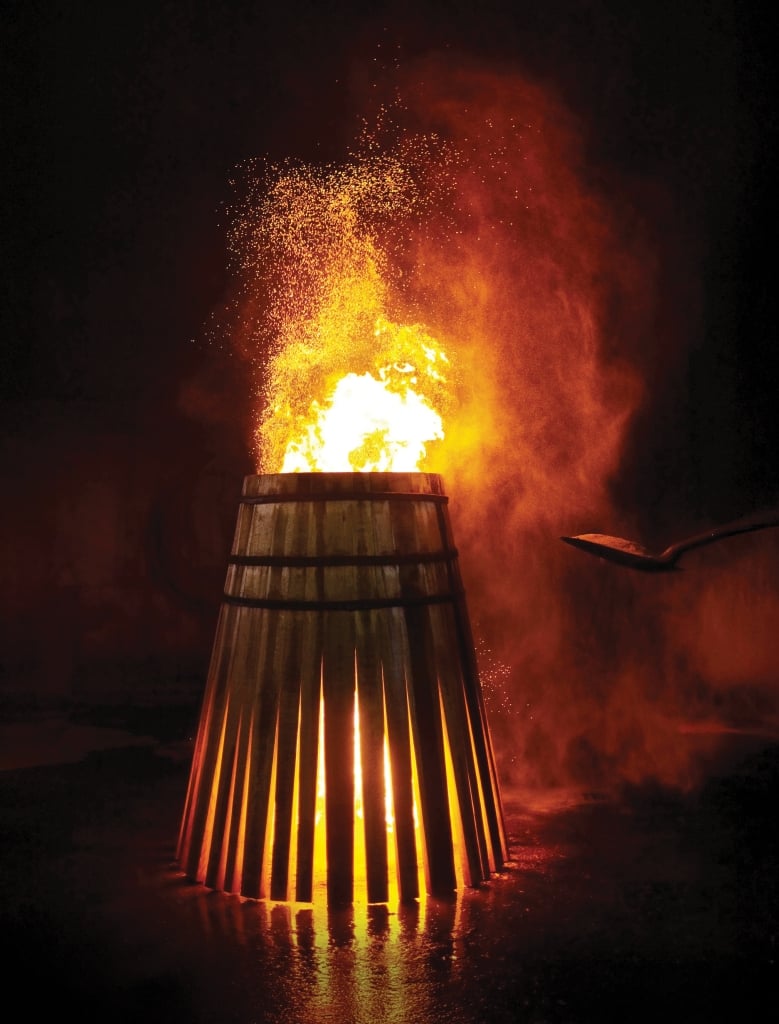
Charring casks at The Macallan cooperage.
TRIAL BY FIRE
While the 53-gallon size and construction may be relatively standard, the next steps are where different distilleries impart their own methodologies. “More than 60% of the wood’s weight is water, so you have to get that free water out of it,” Wilson says. “You can send the wood to the kiln, or you can naturally season and air dry, which is what we do at Michter’s. That not only physically dries the wood, but chemically and microbiologically changes it, getting rid of compounds that you don’t want and exposing compounds in the wood that you do want.”
Similar to Michter’s, Macallan also air-dries their wood over the course of an initial two years of their entire six-year process of curating the perfect cask. The oak is dried as a log for one year, then, once cut into staves, the oak dries under the sun for another year. Upon reaching a moisture content of 12-16%, the drying process is complete, and the oak is passed on to coopers for the assembly of the cask.
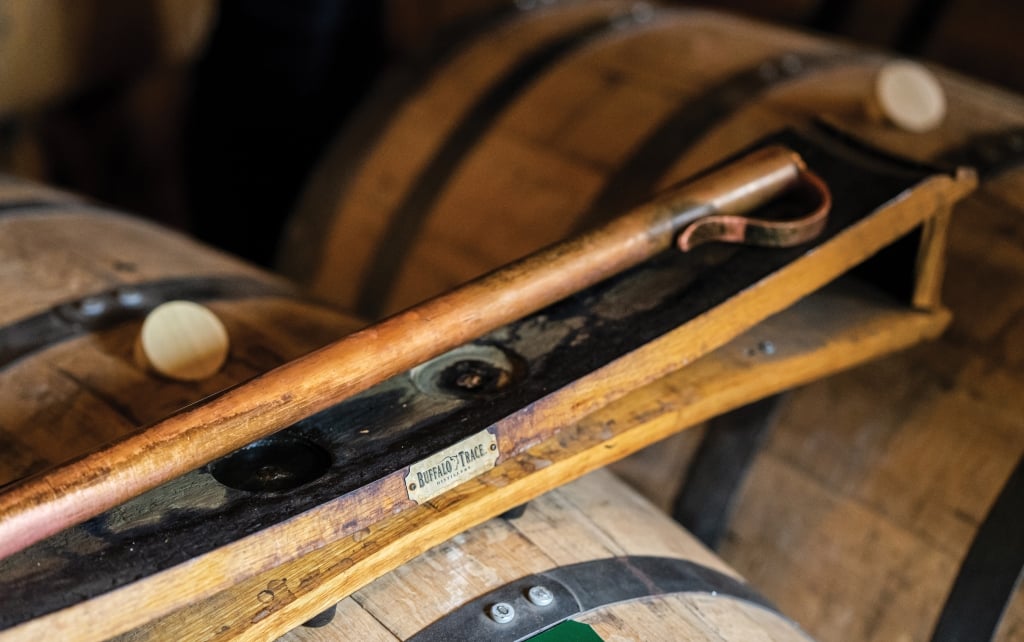
Tasting room at Buffalo Trace.
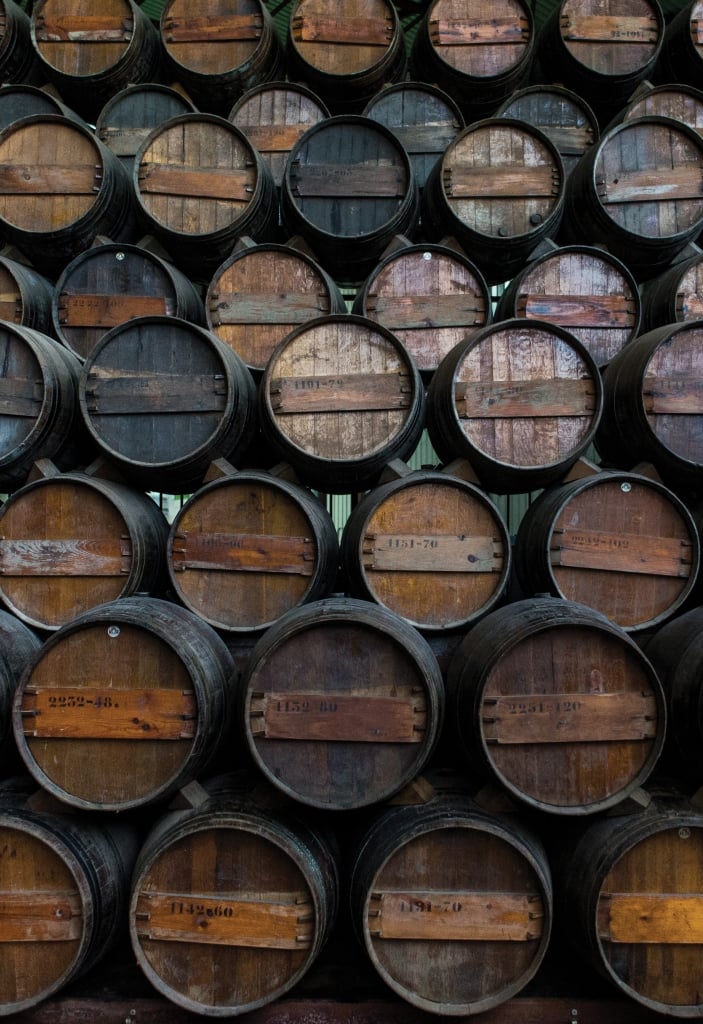
Barrels awaiting a second life.
Cooperages and distilleries vary on how long the seasoning process might last. It can be anywhere between a few months to several years. Likewise, once a barrel has been assembled, each spirits maker will have their own approach to preparing it before it’s filled, and those specifics are held close to the vest.
“Toasting is the art of slowly heating the wood over a fire to break down various aspects of the oak for certain extractives during the aging process,” Wilson says. “Charring is when you physically ignite the interior of the barrel, and then squelch it at the appropriate char level.” Standard char levels range from one, about 15 seconds, to four, about 55 seconds, which is also known as alligator char. Charring isn’t just for show, of course. Lighter chars accentuate elements such as fruit esters and spices, while darker char levels accentuate characters such as chocolate, coffee or smokiness.

Draining a cask at Buffalo Trace
To enhance the aging process, Michter’s, Buffalo Trace and many other brands use a process in their warehouses called heat cycling. “Kentucky has all these great seasonal changes, all of which impact the aging,” says Wilson. “By simulating the seasons — heating up the warehouse like it’s summer, then turning off the heat and letting the barrels cool down —we’re stimulating more interaction with the wood and increasing the maturing quality, pulling out all of those beautiful extractives.” Increasing warmth creates pressure and pushes whiskey into the capillaries of the wood. When the temperature is brought down, the liquid moves back into the barrel, drawing out color, flavor and aroma.
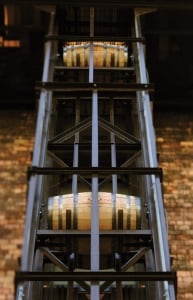
Barrel Elevator
Even within the bounds of laws and long-standing traditions, the maturation process requires a blend of art, science and constant experimentation. When a product is being aged for 20 years, there is a lot on the line. It isn’t simply poured into the barrel and left to gather dust in the back of the warehouse. “You want to know what it looks like at five, 10, 15 years and all the steps along the way,” Wilson says. “What is the timeline of that whiskey as it ages? How does the chemistry profile change? From that basis of knowledge and understanding, you can start changing different variables on an engineered basis.”
Maturation is a complex mystery that unfolds over years, but its essence can be appreciated at the first unique sip. “So many factors go into the taste of bourbon and whiskey, whether it’s the entry proof, the grains, the warehouse location, the process or even the people making it,” says Mayville. “The barrel has the most impact on bourbon because you’re only using it once. There is more extraction, flavor and color, all naturally derived from the wood.
Sea Island Barrels
At any given point throughout the year, Sea Island features between 16 and 18 different single barrel or private label offerings — including bourbons, ryes, rums, tequilas and even gins. “Our collections are extraordinarily unique,” says Nic Wallace, Resort Bars and Spirits Manager. “The team is always looking for something specifically for the palates of our members and guests, something they can’t find anywhere else.”
 As an example of the adventures behind the single barrel program, Wallace cites High West Distillery out of Park City, Utah. “We’ve worked with them for years, and wanted to do something special,” he says. “So, we partnered with them and nearby Ritual Chocolate to create the first-ever cocoa-finished barrel.” A blend of three different whiskeys, which had been aged for six to eight years in classic American white oak barrels, bided its time in a stainless-steel tank. Meanwhile, the empty wet barrel was filled with raw cocoa nibs by Ritual, an award-winning small batch, bean-to-bar chocolate maker that uses ethically sourced, heirloom cacao. After a period of time, the nibs were removed, and the barrel was sent back to High West to finish the spirit for a year before being bottled.
As an example of the adventures behind the single barrel program, Wallace cites High West Distillery out of Park City, Utah. “We’ve worked with them for years, and wanted to do something special,” he says. “So, we partnered with them and nearby Ritual Chocolate to create the first-ever cocoa-finished barrel.” A blend of three different whiskeys, which had been aged for six to eight years in classic American white oak barrels, bided its time in a stainless-steel tank. Meanwhile, the empty wet barrel was filled with raw cocoa nibs by Ritual, an award-winning small batch, bean-to-bar chocolate maker that uses ethically sourced, heirloom cacao. After a period of time, the nibs were removed, and the barrel was sent back to High West to finish the spirit for a year before being bottled.
“The whiskey turned out beautifully, and we have the barrel on display in our wine cellar,” Wallace says. “We also had Ritual create a chocolate using the cocoa that had been aged in the barrel, so we have that chocolate on property as well.”
Some of the other projects have included so-called boomerang barrels, such as Sea Island tequilas aged in Weller and Blanton’s barrels from bourbons that had already been sold at the resort. Cologne from Scents of Wood. Coffee beans placed in barrel at Richland Rum for infusion. Barrel shavings used for infusion.
Every barrel is like a fingerprint. So, when Nic Wallace picks a barrel for Sea Island, it will have a different flavor profile than any other spirit at another resort or bar.”
Wallace further emphasizes Mayville’s point, “I want the diamond in the rough, the unique and strange barrel forgotten in the depths of the warehouse, the gem the distiller can’t wait to talk about. Finding a product that the brand also thinks is truly one-of-a-kind is a rare thing, but an amazing tool in our arsenal when we get them.”
CHAPTERS AFTER BOURBON

Coffee beans placed in barrel at Richland Rum for infusion
Every barrel is like a fingerprint. So, when Nic Wallace picks a barrel for Sea Island, it will have a different flavor profile than any other spirit at another resort or bar.”
As one might guess, the spirits industry’s efforts towards sustainability include investments in forest conservation and replanting. It’s also remarkable to see the versatile ways that used barrels end up being repurposed, from other types of spirits, wines and beers to food items such as hot sauces, jams and syrups. Even unconventional items such as coffee, balsamics and scents are finding their place in the barrel.
In 2019, Scents of Wood, based in Park City, Utah, pioneered a one-of-a-kind process in the fragrance industry. The company ages its organic sugar cane alcohol, which is used to dilute essential oils, anywhere from one to eight weeks. For instance, an acacia barrel will require one week of aging, whereas a French oak barrel will need eight.
“We love experimenting with vintage barrels — barrels that have had a life before perfume,” says Founder Fabrice Croisé. “They bring their natural woodiness to us, but also the booziness emanating from their previous utilization in wine or spirits. Vintage barrels are one-of-a-kind, so any fragrance using a vintage barrel is de facto a limited edition.” Sometimes the barrels follow an even more interesting path, such as an American oak barrel that was used to age bourbon for 12 years, then purchased by a maple syrup producer in Canada before arriving at Scents of Wood. “He aged his syrup in it for three years before selling it to us,” Croisé says. “This barrel has had three lives.”
Aromas and infusion are central to barrel aging, and Richland Rum brings them to life in their rum barrel-aged coffee. Over the course of three weeks, they age raw green coffee beans in what was once a rum-soaked barrel to absorb various hints of nutty, chocolaty and caramelized notes. This delicate process rounds out the coffee, amplifying the slight reflection in flavor that the coffee and rum already possess.
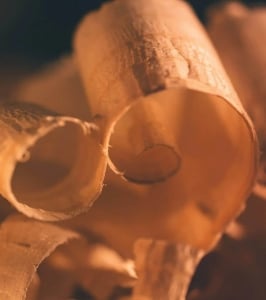
The foundation of this meticulous curation begins with the coffee bean itself. Owner and Founder of Richland Rum, Erik Vonk, explains, “Coffee beans can roughly be divided into two groups, Robusta and Arabica beans. Arabica coffee beans tend to be more refined, more flavorful and have a broader aroma profile than the Robusta beans, which tend to be a little sharper and harsher in flavor.” More specifically, Vonk has found that Peruvian Arabica coffee beans have the perfect ability to infuse the notable flavors that are quietly coating the barrel they’re in.
The journey of Richland Rum coffee has been marked by experimentation, but it was the introduction of the barrel that helped them finally achieve their goal of creating a graceful harmony between rum and coffee. As Vonk details, “In culinary art, the most attractive combinations come from finding subtle ways to introduce flavors and aromas to one another.”
According to Mayville, Sazerac strives to use barrels internally first for a variety of spirits and brands. Corazón Tequila’s Expresiones del Corazón is one example, a series of añejo tequilas that were aged in Buffalo Trace Antique Collection barrels. Another was last year’s launch of the Myers’s Rum Signature Cask Collection, also finished in the Antique Collection. However, used barrels haven’t always been so popular. “When I first came to Buffalo Trace 20 years ago, nobody was buying barrels,” he says. “The Scotch industry was down, and so the barrels would be cut up and sold for planters at the hardware store. Now there’s a lot of demand and they’re pretty expensive.”
Michter’s uses some previously used bourbon barrels to make its unblended American whiskey, but the rest are sold anonymously through a broker into the Scotch industry. “They’ll be used many times through various techniques to repurpose the barrel and draw out any additional extractives from that oak after we’re done using it,” Wilson says. One of the ways of rejuvenating a barrel includes scraping a thin layer of wood from the inside, and then toasting or re-charring it. “A barrel can go on to have many, many years of use, which is part of the sustainability overall for spirits across the globe.”
Macallan has paired its 200 years of whiskey-making with regenerative agriculture, land management and biodiversity initiatives that push barrel-making toward greater sustainability. These efforts, alongside their zero wood waste commitment, support their goal of reaching net-zero emissions by 2045.
In the end, a barrel is more than simply a vessel. It is a storyteller that imparts a one-of-a-kind character onto all that it holds. Each chapter, from forest to distillery, adds depth to its legacy.




